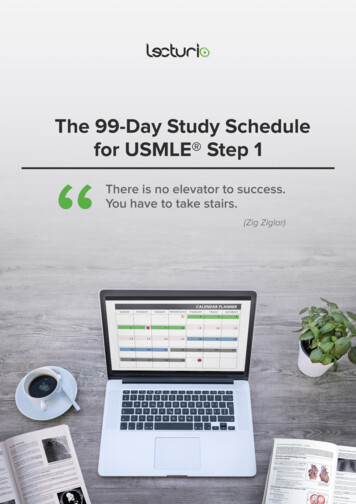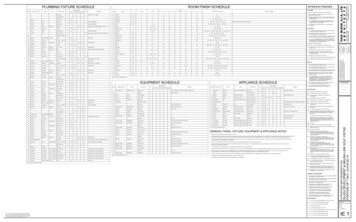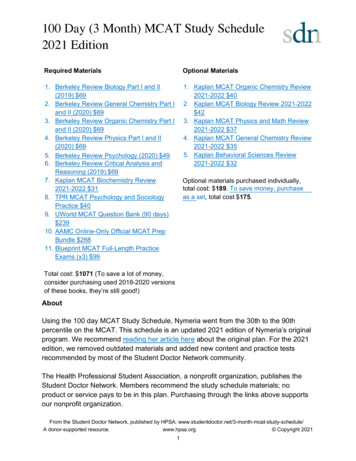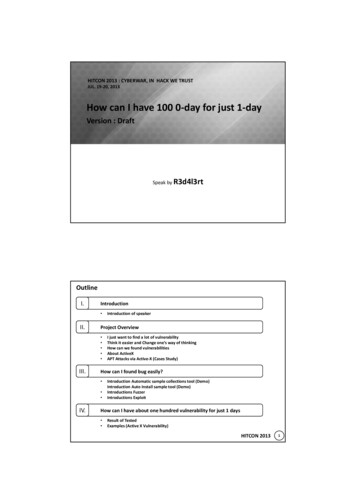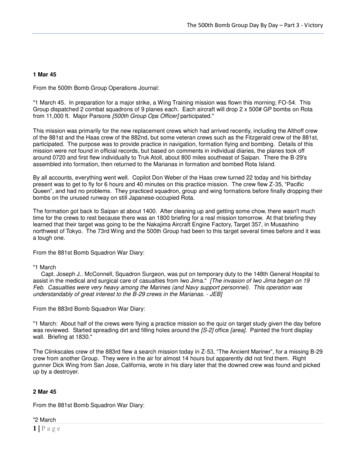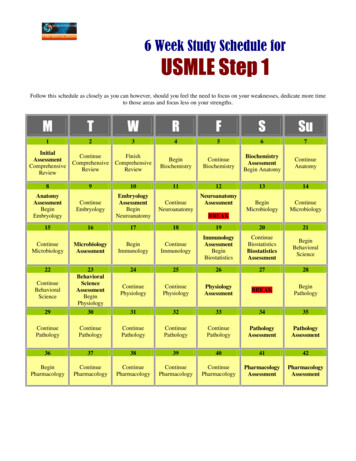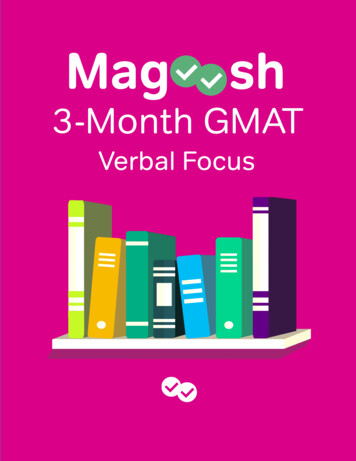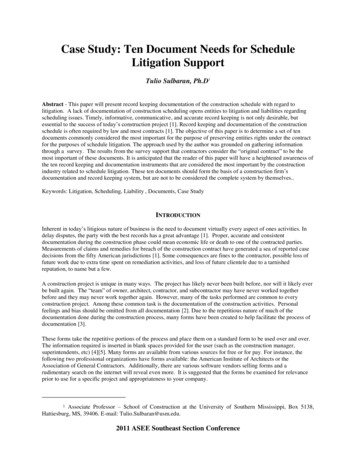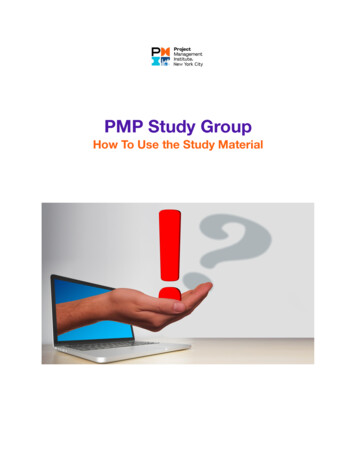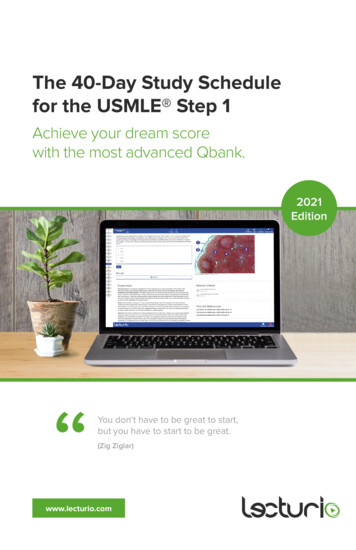
Transcription
The 40-Day Study Schedulefor the USMLE Step 1Achieve your dream scorewith the most advanced Qbank.2021EditionYou don‘t have to be great to start,but you have to start to be great.(Zig Ziglar)www.lecturio.com
About this ScheduleSwitch on studies,switch off everything else.The USMLE Step 1 exam is more important today than it has ever been. YourUSMLE Step 1 score is currently a gatekeeper for the most sought-after residencyprograms – and it will still be important, even once Step 1 changes to pass/fail.Don’t let your opportunity to shine on Step 1 slip through your fingers. You don’twant to take the USMLE Step 1 exam and then wish you could have gotten abetter score. You want to do your absolute best right now!What’s more, you should never listen when another medical student, or anyonefor that matter, says it’s impossible to ace the USMLE Step 1 exam. Each year,students around the nation achieve top scores and match into their top choiceresidency programs. ANY medical student can get an excellent score on theUSMLE Step 1 exam; it’s all about how strategically you plan and how carefullyyou study. Traditionally, students spend three months studying solely for theUSMLE . However, life and circumstances don’t always give you the luxury of adedicated 3-month period to study for the USMLE Step 1 exam. Some medicalschools might only allow for a single month of dedicated study time. Alternatively,students may find themselves with other responsibilities that don’t allow them tostudy full-time.When life gives you lemons, make lemonade! When life gives you one monthto ace that USMLE Step 1 exam, you study in the most strategic way possibleand make the most out of each day. When USMLE Step 1 is only a month away,there’s little time to be able to watch various lecture videos explaining all thebasic science concepts a second time around, let alone taking down meticulousnotes on every topic. Instead, the best use of your limited time will be to focus onlearning high-yield medical concepts and practice taking USMLE -style tests. Themost effective tool for doing both of these is a Qbank. We recommend that youexclusively and consistently work with our Qbank questions and accompanyinghigh-yield material for the entire month. This will require you to adopt a focusedstudy strategy.As part of this strategy, you will need to memorize the medical concepts covered1
by each Qbank question. At the same time, you must get the mechanics of readingand answering USMLE questions under your belt. Stick to our recommendedstudy plan and we promise your rewards can be great. When your study planends in about a month’s time, you will have absorbed all you need to score highon Step 1.Over the course of the next 40 days, you will: Complete more than 2,200 challenging USMLE -style questions using the Lecturio Qbank Understand why your answers are correct or incorrect through in-depthexplanations of both wrong and right answers Reinforce your knowledge of all medical concepts relevant to USMLE Step 1success through video lectures linked to each question Absorb the most important facts through high-yield information presented inyour First Aid book, with references for each Qbank question Deepen your understanding of the USMLE Step 1 exam and tackle it with totalconfidenceWhy Lecturio is your best bet for USMLE prepThe Lecturio Question Bank is not your average Qbank, but rather the epicenter fromwhich you can access all relevant content: written explanations, vivid illustrations,linked video lectures, handpicked First Aid references, and much more.VideoLecturesExplanationsUSMLESTEP 1QbankFirst Aid ReferencesStudySchedule2
About this ScheduleThe Lecturio Qbank at a glance:Lecturio’s Qbank questions are at least as good as Uworld’s, some say better.Don’t believe us? Try them out! All Lecturio Qbank questions are based on the mostrecent NBME standards, meaning all questions are very similar to USMLE examquestion formats. This is crucial – practice questions that have been written asclosely as possible to the format and style of the real exam questions will prepareyou better than just learning the content. What’s more, we can even offer you anexamination environment with our exam-simulation interface. If you switch to “testmode,” you’ll be given the same technical settings, just like in the real exam.Almost every Qbank question is a real-life clinical scenario with up-to-date andinformative illustrations. This also helps make everything as true to test day aspossible. However, as you study and learn with the Qbank you’ll also find detailedexplanations to all incorrect and correct answer choices; these accentuate theprofessional learning environment that is Lecturio.Our Qbank offers something no one else does – Lecturio links all of its relevant,high-yield video lectures to every concept discussed in every Qbank question.Why is this so great? Because you can apply what experts call “reverse studying;”instead of going through a bulk of material, of which only a percentage will berelevant for the USMLE exam, you can selectively watch those explanatory videosin which you display obvious knowledge gaps. Awesome, right?!And as if this wasn’t enough, you’ll also find the most up-to-date, handpickedFirst Aid references added to each question whenever you switch “tutor mode” on.Want to know how to best tackle these clinical case questions?Check out our Qbank Walkthrough course, in which Doc Ossarehwalks you through 30 individual case questions for Step 1.3
Additional Resource: The Medical School Survival GuideProviding you with the guidance you needLecturio not only provides you with every piece of content you need to know foryour exams, we also strive to play the role of study buddy, or upperclassman.To preserve our knowledge for future med student generations, we have createda specific course with an accompanying eBook, which together help you understand the philosophy, techniques, and strategies behind important tests, such asthe board exams.Video course: Medical School Survival GuideThis course focuses on the high-yieldinformation you need for a successfulmedical school application. It willalso help to prepare you for medicalschool, providing guidance up untilthe fourth year. Don’t hesitate! Don’tpanic! Lecturio has your back for what’sahead. Start Course Now eBook: Medical School Survival GuideRefer to our Medical School Survival Guide to learnmore about proven test-taking strategies, crucialUSMLE exam facts, and helpful advice about themost efficient study techniques with the greatestrecall. The Medical School Survival Guide is youressential companion. You can rely on it to help yousurvive from day one of medical school right up untilyou match into your residency program of choice. Download 4
About this ScheduleHow We Created This ScheduleEveryone has his or her own way of studying, learning, and taking tests. But eventhough medical students excel in learning and time-management, preparing for theUSMLE Step 1 exam represents the ultimate challenge for any level of academicability. It requires a very different study strategy from that of more traditional medschool exam preparation, and with the clock rapidly ticking you are under intensepressure. You just don’t have enough time to sort through vast volumes of irrelevantinformation. The key to successful USMLE Step 1 study is to cherry-pick the rightresources, know how to effectively use them, and be able to implement the beststrategies to ace this unique exam.Med school upperclassmen have long been a primary source of information forunderclassmen with regards the USMLE Step 1. First-year med students traditionallyturn to them for “how to do well on this exam” advice. The idea behind Lecturio asa USMLE Step 1 resource is to offer more information and advice than you couldever expect to receive from upperclassmen alone.Lecturio takes things to the next level by including evidence-based recommendations.We developed our approach by working directly with medical students, residents,and attending physicians across the nation. We have picked the minds of those whoachieved top USMLE Step 1 scores, asking them to explain their study methodswhen faced with such a narrow window of time. We analyzed their responses andused those insights as the basis for creating what we believe is the most effectiveUSMLE Step 1 study strategy out there.You will find the evidence-based advice of these past test-takers summarized onthe following pages. You will also realize that our study schedule design reflectsUSMLE Step 1’s double aim to test your knowledge and assess your studystrategies as far as high-stakes examinations are concerned. Our study schedulealso appreciates that you have very little time in which to prepare. Due to the brevityof the USMLE study time frame, we recommend you prepare exclusively with ourQbank.5
The reasoning behind the implementation of a Qbank is simple: it addresses yourneed to acquire a well-developed knowledge base through clinical vignettes anddetailed solutions specifically designed to teach high-yield medical concepts.Because Lecturio’s Qbank questions are styled after those on the actual USMLE Step 1 exam, you will learn how to quickly, efficiently, and effectively work your waythrough question stems and answer choices. There really is no better resource forintensive USMLE Step 1 study than a solidly constructed Qbank.About Lecturio:Walk into any Lecturio meeting and the focus is onproducing the highest quality educational resourcesthat lead to student success. Lecturio has worked withmedical education leaders across the nation to producean evidence-based comprehensive medical school andUSMLE preparation platform.6
Study Plan OverviewDay 1Day 2Day 3Day 4Day 5Day 6Day 7Week mmunologyMicrobiologyMicrobiologyWeek 2MicrobiologyMicrobiologyPathologyHigh YieldPrinciplesCardiovascularWeek 3Cardiovascular CardiovascularWeek 4Hematology & Hematology & Hematology &OncologyOncologyOncologyEndocrinePharmacology Public trointestinalMCTMCTMCTNeurologyWeek 5NeurologyPsychiatryPsychiatryRenalRenalWeek 6RespiratoryRespiratoryRespiratoryHigh YieldSystemsPracticeExamReproductive ReproductiveFor the next 40 study days, you will – by adopting this schedule – use a Qbankto learn high-yield medical concepts and test-taking strategies. Each new Qbankquestion you complete during this period will expand your knowledge-base andfamiliarize you with the best way to work through other questions like it.On some days, you will have one question block to complete rather than two.These are often the days in which you start a new subject, and therefore theschedule provides additional time to review with additional concepts. On thesedays especially, make sure you’re reviewing the related concepts with First Aid oranother reference book of your choice (or check out some Lecturio video lecturesto switch it up!). Each topic has updated First Aid references listed within theLecturio platform.A more detailed schedule can be found on the following pages.7
Subject/SystemDayNoQbank SettingsGetting Started1Self-Assessment4 Blocks, 120 Qbank questions totalBiochemistry2Molecular and Cellular Biochemistry & Lab TechniquesGenetics2 Blocks, 65 Qbank questions totalBiochemistry3NutritionMetabolism2 Blocks, 70 Qbank questions totalImmunology4Lymphoid Structures & Cellular Components1 Block, 26 Qbank questionsImmunology5Immune ResponsesImmune Responses & Immunosuppressants2 Blocks, 72 Qbank questions totalMicrobiology6Basic & Clinical Bacteriology1 Block, 42 Qbank questionsMicrobiology7Clinical BacteriologyClinical Bacteriology2 Blocks, 70 Qbank questions totalMicrobiology8Mycology & ParasitologyVirology2 Blocks, 80 Qbank questions totalMicrobiology9SystemsAntimicrobials2 Blocks, 83 Qbank questions totalPathology10Cellular Injury, Inflammation & Neoplasia1 Block, 48 Qbank questions8
Study Plan OverviewSubject/SystemDayNoQbank Settings11PK/PD, Autonomic Drugs, Toxicities and Side Effects1 Block, 42 Qbank questionsPublic HealthSciences12Epidemiology & BiostatisticsEthics, The Well Patient, Healthcare Delivery & Qualityand Safety2 Blocks, 80 Qbank questions totalRecap 13High Yield Principles4 Blocks, 280 Qbank questions totalCardiovascular14Embryology, Anatomy & Physiology1 Block, 46 Qbank questionsCardiovascular15PathologyPathology2 Blocks, 87 Qbank questions totalCardiovascular16PathologyPharmacology2 Blocks, 82 Qbank questions totalEndocrine17Embryology, Anatomy & Physiology1 Block, 15 Qbank 3 Blocks, 90 Qbank questions totalGastrointestinal19Embryology, Anatomy & Physiology1 Block, 32 Qbank questionsGastrointestinal20PathologyPathology2 Blocks, 87 Qbank questions totalPharmacology9
Subject/SystemDayNoQbank cology3 Blocks, 69 Qbank questions totalHematology &Oncology22Embryology, Anatomy & Physiology1 Block, 20 Qbank questionsHematology &Oncology23PathologyPathology2 Blocks, 82 Qbank questions totalHematology &Oncology24PathologyPharmacology2 Blocks, 55 Qbank questions totalMusculoskeletal, Skin& Connective Tissues25Embryology, Anatomy & Physiology1 Block, 27 Qbank questionsMusculoskeletal, Skin& Connective Tissues26PathologyPathology2 Blocks, 61 Qbank questions totalMusculoskeletal, Skin& Connective Tissues27DermatologyPharmacology2 Blocks, 56 Qbank questions totalNeurology & SpecialSenses28Embryology, Anatomy & PhysiologyPathology2 Blocks, 55 Qbank questions totalNeurology & SpecialSenses29PathologyOtology & OphthalmologyPharmacology3 Blocks, 76 Qbank questions totalPsychiatry30Psychology & Pathology1 Block, 46 Qbank questions10
Study Plan OverviewSubject/SystemDayNoQbank SettingsPsychiatry31Psychology & PathologyPharmacology2 Blocks, 87 Qbank questions totalRenal32Embry
However, life and circumstances don’t always give you the luxury of a dedicated 3-month period to study for the USMLE Step 1 exam. Some medical schools might only allow for a single month of dedicated study time. Alternatively, students may find themselves with other responsibilities that don’t allow them to study full-time. When life gives you lemons, make lemonade! When life gives you .
